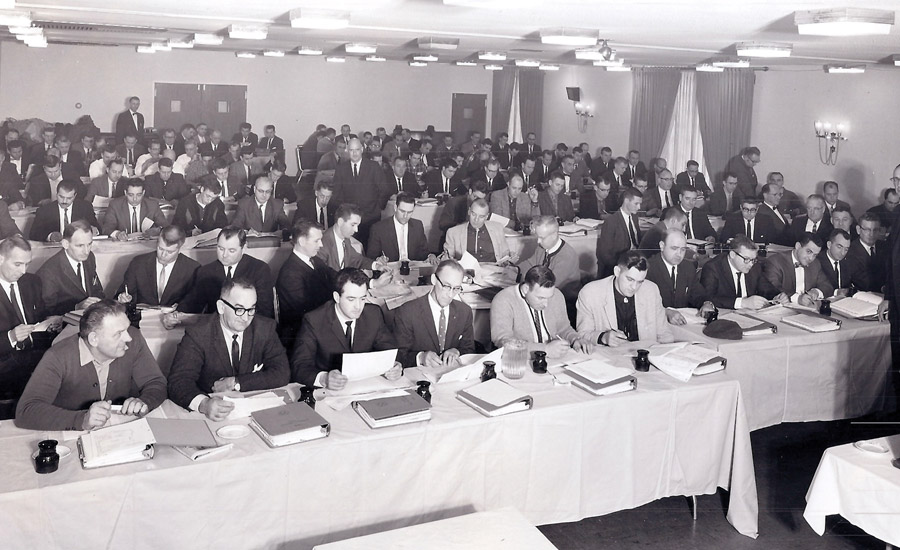Throughout 100 years of changes and challenges, one thing has remained constant at the Hydronics Institute (HI): The organization’s commitment to serving the professional tradesmen and tradeswomen who make the hydronics industry great.
The HI celebrates its 100-year anniversary this year, tracing its roots back to the National Boiler and Radiator Manufacturers, which formed in 1915 with about 15 members. The association’s goal was to help ensure proper sizing, efficiency, and safety of hydronics equipment, which, back then, focused specifically on large residential boilers. Combustion products in the home were a new venture at that time, and safety was paramount to the association’s mission.
Records indicate the association’s founders raised $12,000 and used that to finance the writing of regulations for the manufacture of boilers that became the ASME code for boilers and pressure vessels.
Today, HI is a section of the Air-Conditioning, Heating, and Refrigeration Institute (AHRI) and includes nearly 70 members.
“The founders of the National Boiler and Radiator Manufacturers put a group together to basically set safety and efficiency standards for manufacturers and also to put together a code for installation,” said Ron Passafaro, president and CEO, ECR Intl. Inc., and HI section chairman at AHRI. “They wanted to guard against ‘do it yourselfers’ because they understood boilers that combined pressure and combustible products should be installed by professional tradesmen. Obviously, we as an industry have continued that commitment to this day.
“The U.S. Department of Energy [DOE] was founded in 1977,” Passafaro added. “There we were in 1915, as a self-regulated industry, basically fulfilling the mission of what government is trying to do today.”
Janine Brady, certification coordinator at AHRI, said the formation of the I=B=R schools in the 1950s was a key event in HI’s history. “It was important to train contractors, installers, engineers, and anyone who was interested in learning the proper installation of hydronic systems, both residential and commercial,” she said. Brady estimated that I=B=R schools trained at least 35,000 students over the years.
The I=B=R schools functioned as the educational arm of HI for more than 40 years, until hydronic equipment manufacturers began creating their own schools.
“The manufacturers do a fine job with their training — in particular by bringing students into their corporations for hands-on, live-fire training, which is so dynamic,” Passafaro said. “But one of the things we lost with the demise of the I=B=R schools was the academic objectivity. Manufacturer training is typically specific to that manufacturer. I=B=R was soup-to-nuts system training.”
GROWING AND CHANGING
Two major mergers have helped define HI’s history. The first occurred in 1995, when the institute merged with the Gas Appliance Manufacturers Association (GAMA), and the second in 2008, when GAMA merged with the Air-Conditioning and Refrigeration Institute (ARI) to become AHRI.
“HI has been a very welcome addition,” said Francis Dietz, vice president of public affairs, AHRI. “They’ve worked well with us, and our two organizations have similar goals. Anytime you have a merger of two organizations, there are going to be some hiccups here and there — HI underwent two mergers in 13 years — but we’ve all operated in good faith and have developed a good working relationship.”
Bill Vallett, CEO of Lochinvar LLC and former HI chairman, said the biggest challenge the organization faces today is dealing with government regulations. “We’re under a lot of pressure from the current administration with many issues related to energy efficiency and climate change,” he said. “That seems to dominate a lot of political agendas, and our industry is really facing unprecedented regulatory activity.
“In addition to making sure safety and energy standards are implemented properly, my biggest push over the years has been advocacy — ensuring the proposed changes are not just changes for the sake of change, but that they’re economically justifiable,” he added.
Passafaro agreed that regulations are always high on the organization’s agenda.
“Without a doubt, the biggest challenge we’re facing right now is the 2020 efficiency standards the Department of Energy is reviewing for each classification,” he said. “We’re also dealing with changing test procedures for boilers, and we are trying to convince the DOE to follow its own mandate in setting measurement standards before setting minimum AFUE regulations. HI is dealing with these issues with the help of AHRI. We want to be sure our members are compliant, but that they’re also being treated fairly.”
Ayk Yilmaz, manager of certification for AHRI and executive assistant for HI, added that HI is working on a broader project with AHRI to develop a set of standards and guidelines that moves away from defining just appliance or boiler efficiencies and considers building systems as a whole.
“This also fits into the regulatory picture because equipment efficiencies are being pushed about as far as they can go,” Yilmaz noted. “We really need to look at a different way of pushing efficiency even higher in the future that doesn’t tax the appliance solely, but also looks at smarter system design as part of the solution.”
There have been many challenges throughout HI’s 100-year history, and, undoubtedly, more will come. But the organization will continue to overcome challenges the same way it always has — by keeping its focus on serving the people of the hydronics industry.
The Hydronics Institute will hold its centennial celebration Sept. 15-17 at the Stockton Seaview Hotel and Golf Club in Galloway, New Jersey. The event is open to AHRI members who serve on Hydronics Institute product section member companies, alumni members of the Hydronics Institute, and invited guests. For more information, contact Janine Brady at jbrady@ahrinet.org or 703-600-0372.
Publication date: 9/7/2015
Want more HVAC industry news and information? Join The NEWS on Facebook, Twitter, and LinkedIn today!



Report Abusive Comment